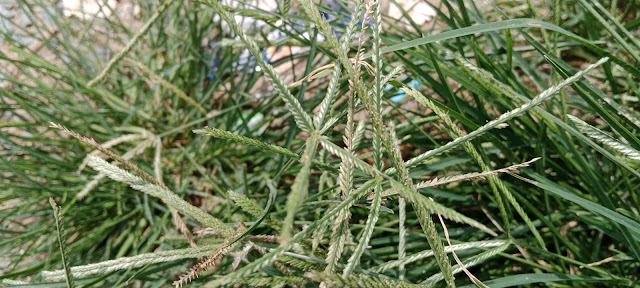Introduction
Indian Goosegrass (Eleusine indica), commonly referred to as
"Goosegrass," is a hardy, fast-growing plant belonging to the Poaceae
family. Native to tropical and subtropical regions, this grass is now found in
diverse ecosystems around the world. Although often considered a weed in
agricultural settings, Indian goosegrass offers a range of benefits to humans,
animals, and the environment. Understanding these benefits can help us
appreciate the ecological and practical value of this plant.
Where Does Indian Goosegrass Grow?
Indian goosegrass thrives in a wide variety of environments.
It grows best in tropical, subtropical, and warm temperate climates, preferring
disturbed areas such as roadsides, agricultural fields, and lawns. It is
commonly found in tropical and subtropical countries, particularly in regions
of Asia, Africa, the Americas, and the Pacific Islands.
Key Growth Habitats:
- Agricultural
fields (particularly rice, maize, and other cereal crops)
- Lawns,
pastures, and grasslands
- Roadways,
vacant lots, and disturbed soils
Where is Indian Goosegrass Found Globally?
Indian goosegrass is a highly adaptable species and is
present in many countries across the globe. Some of the key regions and
countries where Indian goosegrass is abundant include:
- Asia:
India, Pakistan, Bangladesh, Thailand, Malaysia, Indonesia, Vietnam
- Africa:
Kenya, Nigeria, Ghana, South Africa
- Americas:
United States (particularly in southern states), Mexico, Brazil, and
Argentina
- Australia
and Pacific Islands
Its global spread is due to the plant's resilience and its
ability to thrive in various environmental conditions, from tropical
rainforests to arid regions.
The Benefits of Indian Goosegrass to Humans, Animals, and
the Environment
1. Benefits to Humans
While Indian goosegrass is often seen as a nuisance in
agriculture due to its competitive nature, it also offers significant potential
benefits:
- Traditional
Medicine: In some cultures, parts of Indian goosegrass are used for
medicinal purposes. The plant is believed to have anti-inflammatory,
antipyretic (fever-reducing), and antimicrobial properties. Extracts from
Indian goosegrass are used in traditional remedies to treat conditions
such as fever, coughs, and skin infections.
- Soil
Health: As a ground cover, it can help in reducing soil erosion,
especially in regions with heavy rainfall or on slopes. Its extensive root
system helps stabilize the soil and prevent degradation.
- Cover
Crop Potential: In agroecological systems, Indian goosegrass can be
used as a cover crop, protecting the soil from erosion and increasing
organic matter in the soil through its decomposition.
2. Benefits to Animals
Indian goosegrass also provides valuable resources for
animals, both in natural habitats and farm environments:
- Forage
for Livestock: While not highly nutritious compared to some other
grasses, Indian goosegrass is still a source of food for herbivores.
Livestock such as cattle, sheep, and goats often graze on it when other
forage options are scarce.
- Wildlife
Habitat: Its dense growth can offer shelter and nesting sites for
small animals, insects, and birds. The plant contributes to biodiversity
in ecosystems, providing food and protection for various species.
3. Environmental Benefits
Indian goosegrass plays an important role in maintaining
ecological balance and improving environmental conditions:
- Erosion
Control: The extensive root system of Indian goosegrass helps prevent
soil erosion, especially in areas prone to water runoff. This is
especially beneficial in agricultural regions where soil degradation can
lead to reduced crop yields.
- Carbon
Sequestration: Like other grasses, Indian goosegrass helps sequester
carbon dioxide, playing a minor but valuable role in mitigating climate
change by reducing greenhouse gas levels.
- Improving
Soil Quality: Indian goosegrass can help enrich the soil by
contributing organic matter, enhancing the soil's structure, and
increasing its water retention capacity. This benefits the overall
fertility of the land, making it more productive for future cultivation.
How Many Species of Indian Goosegrass Are There?
Indian goosegrass (Eleusine indica) is a single
species, though it is part of a larger genus, Eleusine, which contains
several other species. The genus Eleusine has over 10 species, but Eleusine
indica is the most widespread and recognized globally as Indian goosegrass.
It is important to note that while E. indica is the most well-known
species, the genus contains other grasses that are found in different parts of
the world, but they do not have the same invasive or ecological impact as E.
indica.
Origins and History of Indian Goosegrass
Indian goosegrass is believed to have originated in Africa
or the Indian subcontinent, where it has been utilized by humans for thousands
of years. It spread to other parts of the world through human activity,
including trade, agriculture, and transportation of goods. Its ability to grow
in a wide range of conditions has allowed it to establish itself in a diverse
array of environments, making it a common plant in both rural and urban areas.
In summary, Indian goosegrass is a globally distributed,
resilient grass species that has significant ecological, agricultural, and
medicinal value. Despite its reputation as a weed in some agricultural
settings, its contributions to soil health, erosion control, and biodiversity
make it an important part of the global ecosystem.
Conclusion
Indian goosegrass, while often viewed through the lens of
its role as a weed in agricultural fields, offers numerous benefits to humans,
animals, and the environment. From its traditional medicinal uses to its role
in soil conservation and biodiversity, this plant has far-reaching advantages.
Its adaptability to different climates and habitats ensures its continued
presence across the globe, making it an important species for ecological
sustainability and resource management.





